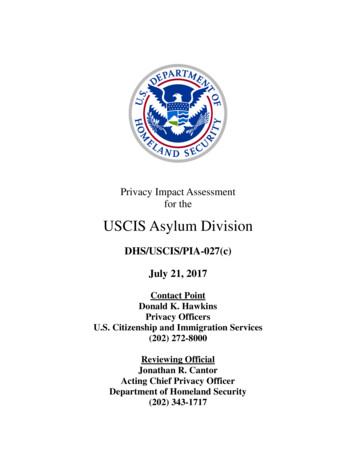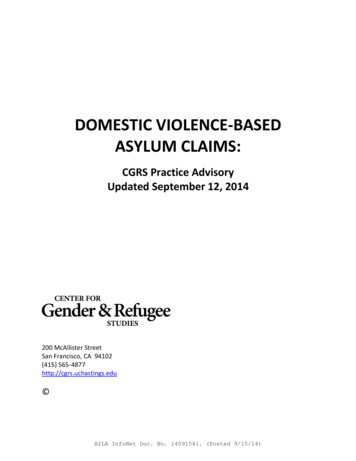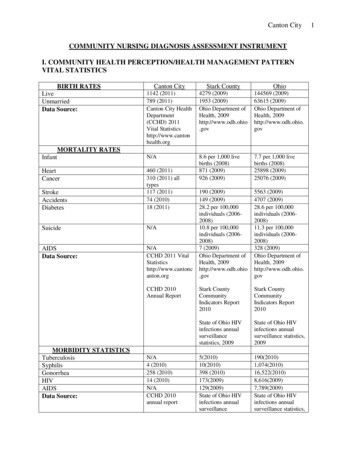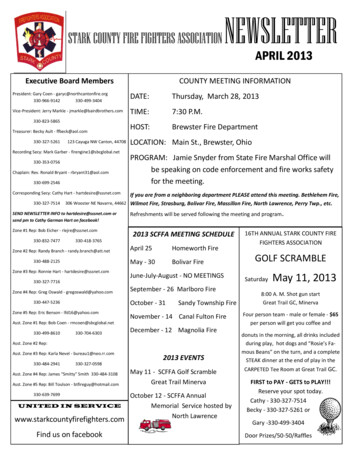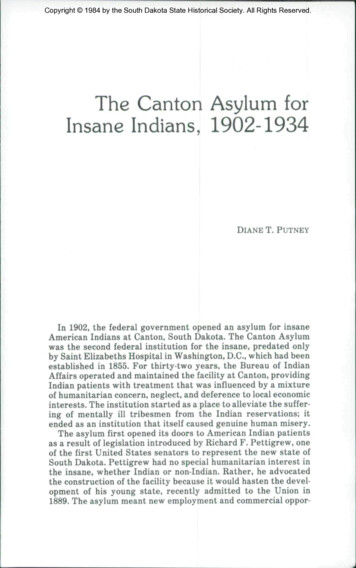
Transcription
Copyright 1984 by the South Dakota State Historical Society. All Rights Reserved.The Canton Asylum forInsane Indians, 1902-1934DIANE T . PUTNEYIn 1902, the federal government opened an asylum for insaneAmerican Indians at Canton, South Dakota. The Canton Asylumwas the second federal institution for the insane, predated onlyby Saint Elizabeths Hospital in Washington, D.C, which had beenestablished in 1855. For thirty-two years, the Bureau of IndianAffairs operated and maintained the facility at Canton, providingIndian patients with treatment that was influenced by a mixtureof humanitarian concern, neglect, and deference to local economicinterests. The institution started as a place to alleviate the suffering of mentally ill tribesmen from the Indian reservations; itended as an institution that itself caused genuine human misery.The asylum first opened its doors to American Indian patientsas a result of legislation introduced by Richard F. Pettigrew, oneof the first United States senators to represent the new state ofSouth Dakota. Pettigrew had no special humanitarian interest inthe insane, whether Indian or non-Indian. Rather, he advocatedthe construction of the facility because it would hasten the development of his young state, recently admitted to the Union in1889. The asylum meant new employment and commercial oppor-
Copyright 1984 by the South Dakota State Historical Society. All Rights Reserved.South Dakota Historytunity for Canton, a town whose first settlers had named it afterCanton, China, thinking that they were located halfway aroundthe earth from that oriental city.'A United States Indian agent at the Cheyenne River Agencyhad suggested the idea of an asylum to Senator Pettigrew in1897. The agent explained that state institutions were reluctantto accept insane Indian patients, and when they did, they chargedexorbitant rates. Often, the only shelters for the insane on thereservations were the guardhouses. The agent estimated thattwo insane Indians could be found on every reservation in theUnited States. Pettigrew was receptive to the agent's suggestion, and in 1899,as chairman of the Senate Committee on Indian Affairs, he introduced a bill for purchase oí land near Canton for construction ofthe asylum. Only then did the senator inquire about the numberof insane Indians in the United States. After polling its agentsand superintendents, the Bureau of Indian Affairs reported thatthere were approximately fifty-eight insane and six "idiotic"Indians living on twenty-one reservations. Seven Indians wereconfined in institutions, five of whom were in Saint ElizabethsHospital, which was operated by the Department of the Interior.These numbers, to Pettigrew, justified the construction of anIndian asylum. The acting commissioner of Indian affairs prepared a statement tepidly in favor of Pettigrew's bill. He stated that such aninstitution would relieve the overcrowding at Saint Elizabethsand eliminate support for Indians in state institutions. The superintendent of Saint Elizabeths, however, plainly objected to thebill. He explained that there were too few insane Indians to warrant the construction and maintenance of a separate facility for1. Writers' Program, South Dakota Work Projects Administration, SouthDakota Place Names (VermiUion: University of South Dakota, 1941), p. 52. For abrief account of Pettigrew's legislative record, see Cornelius R. Kennedy, "TheNext United States Senator from South Dakota," Monthly South Dakotan 3 (Aug.1900): 120-30.2. U.S., Congress. Senate, Committee on Indian Affairs, Asylum for Insane Inrdians, S. Rept. 567, 55th Cong., 2d sess., 11 Feb. 1898, pp. 1-2.3. Ibid., pp. 1-18; Acting Commissioner of Indian Affairs to Secretary of the Interior, 14 July 1897, Letters Sent (hereafter cited as LS). Finance, Records of theBureau of Indian Affairs, Record Group 75. National Archives (hereafter cited asRG 75, NA); R. F. Pettigrew to Secretary of the Interior. 24 June 1897, Letters Received (hereafter cited as LR), 4658, Indian Division, Records of the Secretary ofthe Interior, Record Group 48, National Archives (hereafter cited as ID-SI, RG 48,NA).
Copyright 1984 by the South Dakota State Historical Society. All Rights Reserved.Canton Asylumthem. Acknowledging the overcrowding at Saint Elizabeths, hestated that a recent 75,000 appropriation from Congress wouldease the crowding, as would attrition caused by the deaths of oldand feeble patients. The critical need, according to the superintendent, was better facilities for the "African citizens" of his institution. Following the reasoning of the superintendent, the secretary of the interior opposed Senator Pettigrew's bill. Nonetheless, Congress passed it in 1899 as part of the Indian appropriation act of fiscal year 1900 and authorized 45,000 for the asylum.*Attorney Oscar S. Gifford, former mayor of Canton and congressman from South Dakota (1889-1891), handled the legal paperwork for the acquisition of one hundred acres of land for the facility at thirty dollars an acre. The site was in Lincoln County, a milewest of the Big Sioux River and two miles east of Canton. Neverhaving built an asylum, the Bureau of Indian Affairs secured theservices of an architect outside of the Indian service, JohnCharles, who had experience in the construction of the Tempealeau County Asylum and the Home for Feeble Minded, both inWisconsin. H. S. Pelton and Company of Milwaukee, Wisconsin,submitted the lowest bid for the construction, was awarded thecontract, and began work in 1900. The asylum originally consisted of one building with fourwings. The patients, attendants, physician, and superintendentall Hved in the same structure, which was lighted by one hundredtwenty electric fixtures and heated by coal-stoked boilers and radiators. Water was supplied by a well, but it was hard water, illsuited for laundering and bathing. The building had a basement,bathrooms, and water closets, with a sewerage system that carried refuse away from the main building. The structure and itsplumbing generally withstood the sixty-mile-per-hour wind gales,temperatures of thirty degrees below zero, and deep snows of theharsh South Dakota winters. Between 1901 and 1909, the asylumacquired cow and horse barns, a corn crib, a laundry, and houses4. W. W. Godding to Secretary of the Interior, 23 July 1897. and Theo Smith toSecretary of the Interior, 2 July 1897, LR, 4658. ID-SI, EG 48. NA; R. F. Pettigrewto Assistant Secretary of the Interior, 9 June 1899, LR, 27638, RG 75, NA; Asylumfor Insane Iridian , pp. 2-3; U.S., Department of the Interior, Office of Indian Affairs, AnniioiJÍeporí of the Commissioner of Indian Affairs to the Secretary of theInterior, 1899 (Washington. D.C: Government Printing Office, 1899). p. 503.5. Commissioner of Indian Affairs (hereafter cited as CIA) to Secretary of theInterior, 23 June 1899, LS. Finance; John Charles to CIA, 10 July 1899, LR. 32887;and CIA to Secretary of the Interior, 10 Aug. 1899, LS, Land, all in RG 75, NA.
Copyright 1984 by the South Dakota State Historical Society. All Rights Reserved. 4South Dakota Historyfor poultry, swine, coal, wagon, tools, pump, and gasoline. Twosteel gates were constructed at the entrance to the grounds, andthe words "Hiawatha Asylum" were placed upon the arch of thegates. A seven-foot woven-steel fence surrounded the asylumproperty, enclosing walkways, shrubbery, and young elm, evergreen, white oak, maple, cottonwood, birch, and mountain oaktrees.''The Indian office appointed Oscar Gifford as the first superintendent of the asylum. He assumed responsibility in November1901, while the building was still under construction. A yearlater, his staff consisted of Dr. John F. Turner (assistant superintendent and physician), a financial clerk, a matron, a seamstress,a cook, a laundress, a night watchman, an engineer, two attendants, and two laborers.'On 31 December 1902, the first patient, a Sioux man, age thirtythree, was sent to Canton directly from the Santee reservation inNebraska. By the end of 1903, the asylum housed sixteen Indianpatients, ten males and six females, with one man dying duringthe year. The patients' tribal affiliations were Cherokee, Comanche, Osage, Pawnee, Mission Indian of California, Winnebago,Shoshone, Chippewa, and Sioux. After examining the first fifteenpatients at the asylum. Dr. Turner diagnosed eight differenttypes of mental conditions: chronic epileptic dementia, alcoholicdementia, senile dementia, congenital epileptic idiocy, congenitalimbecility, acute melancholia, chronic melancholia, and chronicmania. Superintendent Gifford described the patients arriving at Canton as "miserably wretched." They had been deserted and neglected by friends and relations or had simply had no one at thereservations to care for them. Many patients suffered from multiple diseases and physical ailments such as paralysis, tuberculosis,pneumonia, influenza, syphilis, edema, and eczema. The patientscraved meats and sweet food. The diet was arranged to allow6. O. S. Gifford to CIA. 11 Jan. 1902. LR, 3363, and O. S. Gifford to CIA. 6 Nov.1901. LR, 65243. RG 75, NA; Inspector McLaughlin to CIA. 25 Oct. 1910, CentralClassified Files (hereafter cited as CCF). 76237-10-150. Canton Asylum (hereaftercited as CA). RG 75. NA; Report of the Commissioner of Indian Affairs, 1903, p326.7. 0. S. Gifford to CIA, 6 Nov. 1901. LR, 65243, and A. 0. Wright to CIA. 30 Jan.1903, LR. 7667, RG 75. NA.8. A. 0. Wright to CIA, 30 Jan. 1903; Report of the Commissioner of Indian Affairs, 1903. pp. 325-26.
Copyright 1984 by the South Dakota State Historical Society. All Rights Reserved.Canton Asylum5Mam building. Canton Asylani fur Insartv Indiansthem sweets, but little meat; they subsisted primarily on a vegetarian diet."Dr. Turner described his regimen for the patients as consistingof cleanliness, suitable diet, proper sleep, and treatment. Histreatment or remedies were of three types: sedatives, reconstructives, and out-of doors activity. Patients who were excessively nervous and prone to convulsions were given sedatives,and bromides in particular were administered to epileptics. Thehot bath was freely used to promote sedation. To revive patientsmentally and physically, in an attempt to "reconstruct" their normal condition and prevent muscular prostration. Dr. Turner prescribed tonics. Weather allowing, outside activities were encouraged.'"9. See Quarterly Sanitary Reports, CA, 1905-1906, LR, and 0. S. Gifford to CIA,20 Mar. 1903, LR, 18929, RG 75, NA.10. Quarterly Sanitary Report, CA, 31 Mar. 1903, LR, 21566, and John F. Turnerto Oscar S. Gifford, 1 Sept. 1907, CCF, 75950-1907-031, CA, RG 75, NA; Report ofthe Commissioner of Indian Affairs, 1903, p. 326; H. R. Hummer, "Insanity amongthe Indians," American Joumal of Insanity 69 (Jan. 1913): 622; Henry M. Hurd, ed.Institutional Care of the Insane in the United States and Canada (1916-1917; reprint ed. New York: Arno, 1973), pp. 391-92.
Copyright 1984 by the South Dakota State Historical Society. All Rights Reserved.South Dakota HistoryThe Canton Asylum was ostensibly maintained to serve thechronically insane, but over the years, all classes of patients weresent to and accepted at the institution, including persons described as imbeciles of different degrees, idiots, the feebleminded, harmless old people, and physically disabled individuals." ' Superintendent Gifford described one patient as a "desper-OscüT S. Giffordate fellow" and more criminal than insane. "He broke out of theguard house at San Carlos twice," Gifford wrote, "stole horsesand got away to the mountains with them, broke in a store andpacked off a quantity of goods, and has committed other offenses.11. A. 0. Wright to CIA, 30 June 1903. LR, 7667. and John Charles to CIA, 9 June1908. CCF. 42412-08-150, CA, RG 75. NA.
Copyright 1984 by the South Dakota State Historical Society. All Rights Reserved.Canton AsylumThe fellow should be confined in a steel cell. We will do our bestwith this fellow but such cases are a little outside of our line."' By 1909, the asylum was described as "a place of refuge for allkinds of defectives."' The asylum operated under two chapters of regulations, approved by the secretary of the interior in 1903. The first chapterpertained to the asylum superintendent's duties and consisted ofnine rules that described the superintendent as the chief executive officer from whom all authority for the control of the asylumemanated. He was responsible for the medical, moral, and physical treatment of the patients. He was the disbursing agent andwas directed to reside on the premises of the asylum and devotehis entire time to the duties of his position. *The second chapter of regulations pertained to employees andincluded forty-three rules. Specific duties of the physician, thematrons, the nurses, and the attendants were addressed, and allof the employees were expected to live at the asylum. Attendantsand nurses were the "guardians" of the patients, and their workwas "exacting to the extreme degree," requiring "great selfcontrol and the exhibition of unusual forebearance." The kicking,striking, shaking, or choking of patients was proscribed, as wasthe throwing of patients to the floor as a means of control. Attendants were to prevent "as far as practicable" patients' violentconduct and profane and obscene language. When the nurses andattendants isolated a patient, they were to report the action tothe physician or person in charge and couid continue the isolationonly with official approval. The physician alone could order theuse of mechanical restraints. All employees were to address thepatients kindly and respectfully, never with ridicule and threats."Work" was to be a feature of treatment, and patients were to assist with house and yard work. The general retiring time for patients was set at 8:00 p.m., and no patient in good health could retire before 7:30 p.m. The nurses were to bathe the patients atleast once a week and keep them as comfortable and clean as conditions permitted.' The Canton Asylum had no established commitment procedures, other than a requirement that all admissions be authorized12. 0. S. Gifford to CIA, 1 Dec. 1906, LR, 106567, RG 75, NA.13. H. R. Hummer to CIA, 22 Sept. 1909, CCF, 95458-09-150, CA, RG 75, NA.14. J. H. Dortch to H. R, Hummer, 8 Nov. 1909, CCF, 86051-09-110, CA, RG 75,NA.15. Ibid.
Copyright 1984 by the South Dakota State Historical Society. All Rights Reserved.8South Dakota Historyby the commissioner of Indian affairs. The commitment of patients generally followed the precedent established by the consignment of Indians to Saint Elizabeths Hospital in Washington,D.C. The reservation agent requested permission from the commissioner of Indian affairs to send the Indian to the hospital inthe nation's capital. Lacking reason to dispute the facts or judgment of the agent, the commissioner then requested authorization from the secretary of the interior. Because the Canton Asylum was under the supervision of the commissioner of Indian affairs, the commissioner himself gave authorization for the commitment of patients. Sometimes an agent would make a requestdirectly to the superintendent in Canton, who in turn wrote forauthorization from the Indian office.' Because some potential patients of Canton Asylum were ofschool age, school superintendents and physicians requestedthose commitments. Parental consent was not required nor secured. A few Indians from Indian Territory were first judged insane by the United States courts before being sent to SouthDakota. On occasion, the staff of the asylum made trips to the reservations in order to escort the Indians. Usually, reservation employees and police accompanied the Indians, and United Statesmarshals brought persons from the Indian Territory."The first death at the asylum occurred on 20 May 1903. According to Dr. Turner's report, the patient was a twenty-one-year-oldSioux male, diagnosed as "dementia, epileptic chronic." The patient retired at 9:00 p.m. and slept for about thirty minutes. Thevictim, who was partially paralyzed, then suffered a violent epileptic convulsion that caused his death.' Superintendent Giffordnotified the agent of the reservation where the dead patient hadoriginally lived, but after receiving no request to send the bodyhome for burial, the superintendent made arrangements for an interment on the grounds of the asylum. A section of land was reserved, and for the next thirty years, it received the remains ofover one hundred Indians; an average of four patients died at theasylum each year. The Bureau of Indian Affairs informed thesuperintendent that the expense of putting up stone markers was16. Ibid. For examples see CIA to Secretary of the Interior, 8 Jan. 1898, LS. Finance; Acting CIA to Charles E. McChesney, 11 May 1897, LS, Finance; and H. R.Hummer to CIA, 21 Dec. 1908, CCF, 86655-08-722.1. CA, all in RG 75, NA.17. H. R. Hummer to CIA, 9 Jan. 1909. CCF, 2895-09-722.1, CA, and Superintendent, Quapaw Agency, to CIA, 21 Sept. 1907, CCF, 79785-07-722.1. CA. RG 75. NA:Report of the Commissioner of Indian Affairs, 1906, p. 745.18. Quarterly Sanitary Report. CA, 30 June 1903, LR, 42256. RG 75. NA.
Copyright 1984 by the South Dakota State Historical Society. All Rights Reserved.Canton Asylumunwarranted, so the graves were unmarked. On a chart hangingin his office, the superintendent recorded the name and locationof each interment. The Episcopal burial service was read over thedead.'"During its history from 1902 to 1934, the Canton Asylum hadonly two superintendents, and both of their administrationsended with scandal and successful efforts by the commissioner ofIndian affairs to remove them from office. Commissioner FrancisE. Leupp forced Oscar Gifford's resignation in the summer of1908. Two years earlier, Leupp had exploded in anger over Gifford's failure to notify the commissioner that a young married patient had become pregnant by a male patient and had given birthto a baby at the asylum. The infant was placed in the Children'sHome in Sioux Falls, South Dakota. A citizen of Canton informedthe commissioner of the birth and suggested that "other affairs"at the institution should be investigated. Dr. Turner, the asylumphysician, also contacted the Indian office and accused Giffordand the asylum clerk of spending too much time away from theirduties. "Leupp ordered an investigation that subsequently cleared thesuperintendent of any responsibility for the pregnancy. The investigator reported that Gifford interfered in medical matters,but that he found nothing improper in Gifford's wife owning stockin the power company that received the electrical contract fromthe asylum. He reported that one of the laborers who recently resigned had been addicted to morphine.*'Throughout 1907 and 1908, the staff at the asylum feuded, andrepercussions from the bickering were felt in Washington, D.C.In April of 1908, Leupp ordered a special agent to Canton to conduct a secret investigation. The agent reported that Gifford hadprevented Dr. Turner from performing surgery on a patient to remove a gall bladder stone, and shortly thereafter, the patient had19. Acting CIA to Superintendent, CA, 23 May 1903, LS, Finance; Acting CIA toH. R. Hummer, 3 Nov. 1908. CCF. 73364-08-044, CA; and George Vaux, Jr,. to[Board of Indian Commissioners], 30 June 1923, CCF. 6719 1923 150. CA, all in RG75, NA; Superintendent. CA. to CIA, 24 Aug. 1911. Microfilm 1011, Reel 7. Target2. NA.20. Elbert Edwards to CIA, 20 Nov. 1906. LR. 103418; CIA to Superintendent,CA, 10 Dec. 1906. LS, Finance; and Acting CIA to Reuben Perry. 23 July 1907.CCF, 70972-1907 150. CA, all in RG 75, NA.21. 0. S. Gifford to CIA, 19 Sept. 1907, CCF, 77872-07-720. CA. RG 75. NA. Seealso correspondence in CCF. 70972-1907-150. CA, RG 75. NA.
Copyright 1984 by the South Dakota State Historical Society. All Rights Reserved.10South Dakota Historydied. The autopsy attributed the cause of death to the stone. Thespecial agent told Leupp, "This incident is an apt illustration ofthe apparent unwisdom of having a layman at the head of an institution that has for its object the treatment of diseased people."The agent also informed the commissioner that Gifford and theclerk were, indeed, too often absent from the asylum. Congressional officials and politicians from South Dakota urged Leupp torefrain from drastic and hasty action over matters at Canton, butLeupp consulted with Secretary of the Interior James R. Garfieldand received his consent to put the administration at Canton onprogressive and "common sense lines." As a necessary step tothat end, Leupp demanded and received Gifford's resignation."Commissioner Leupp sought the advice of the superintendentof Saint Elizabeths, Dr. William A. White, concerning a wellqualified physician to replace Oscar Gifford. When the physicianwhom White had initially suggested declined the offer. White recommended and Leupp accepted Dr. Harry Hummer, who wastwenty-nine years old and had formally applied for the Canton position. Hummer had graduated from Georgetown University witha degree in psychiatry, had interned at Saint Elizabeths, and hadpracticed medicine there for seven years. He was married toNorena Guest, the cousin of the poet Edgar Guest, and movedwith her to Canton in 1908. During Hummer's first full year at Canton, a major feud erupted between the new superintendent and employees on his staff.The trouble started shortly after the arrival of Dr. L. M. Hardin,who replaced Dr. Turner as the assistant superintendent. Although Hummer had requested that Turner's replacement be unmarried because suitable living quarters were lacking, the Indianoffice sent Hardin, who was accompanied by his wife and two children. An Indian office investigation at the Leech Lake reservation had resulted in his transferral to Canton. In September 1909,Hardin sent a letter to the Indian office complaining about hisquarters. Dr. Hummer's "discourteous language," and the crueland harsh treatment of the patients at the asylum. In October, thirteen employees at Canton, including Hardin,sent an affidavit to the Indian office, demanding an investigation22. Edgar A. Allen to CIA, 13 Apr. 1908, CCF, 70972-07-150, CA, RG 75, NA.23. See correspondence in CCF, 70972-07-150, CA, RG 75, NA.24. "Memorandum Relative to Canton Insane Asyium," CCF, 70972-07-150, CA,RG 75, NA; Hummer obituary. Vertical File, Public Library, Canton, S.Dak.25. See correspondence in CCF, 95458-09-150, CA, RG 75, NA.
Copyright 1984 by the South Dakota State Historical Society. All Rights Reserved.Canton Asylum11of Hummer based upon a series of specific charges they leveledagainst him. Some of the accusations were that he failed to issuethe proper clothing and rations to patients, that the patients andtheir bedding were unclean, and that nonviolent patients werelocked up for long periods of time. The employees sent copies ofthe charges to the executive officer of the Indian Rights Association and to Congressman Charles H. Burke of South Dakota, bothof whom queried the Indian office about the situation at Canton.A newspaper in Sioux Falls, South Dakota, printed the charges.The thirteen employees threatened to resign en mass if conditions at the asylum did not improve. *"Commissioner of Indian Affairs Robert G. Valentine sentCharles L. Davis to conduct an investigation, and Davis recommended Hummer's removal from the asylum. Joseph H. Dortch,however, who was the chief clerk in the Indian office, suggestedto the commissioner that no quick action be taken against Hummer until Dr. Joseph Murphy, the chief of the health section ofthe Indian service, investigated the Canton Asylum. Dortch believed that Hummer was the victim of the turmoil at Cantoncaused by Leupp's dismissal of Superintendent Gifford. Hethought Hummer needed more time to straighten out the disorganization and to calm the dissension that he had found upon assuming his post as superintendent. Dr. Murphy went to SouthDakota, investigated the controversy there, and concluded thatDr. Hummer was financially and morally "above reproach" andfully qualified professionally, although he did find that the superintendent was ill-tempered and used abusive language. As a result of Murphy's investigation. Hummer remained as superintendent, and some employees resigned or were transferred ordismissed. Employee-management relations at the asylum were peacefuluntil 1914 and 1915, when the Indian office again investigatedcharges against Hummer, brought by former workers at the asylum. In both of these new investigations, which concerned Hummer's relationship with female employees, the superintendentwas cleared of the allegations of misconduct. In contrast with theearlier turmoil, the charges in 1914 and 1915 were made withoutpublicity, and the investigations were conducted quietly."26. Ibid.I27. Ibid.28. CIA to L. A. Dorrington. 2 Feb. 1914, CCF, 238-1914-154. CA, and CIA to Dr.Hummer, 15 May 1916, CCF, 675311915-154, CA, RG 75, NA,
Copyright 1984 by the South Dakota State Historical Society. All Rights Reserved.12South Dakota HistoryAs had his predecessor. Superintendent Hummer believed thatexercise and recreation were integral parts of the therapeutictreatment of patients. When the Indian office was installing playground equipment at the Indian boarding schools in 1912 and1913, Hummer gladly accepted the few pieces of equipment sentto Canton: six swings, a giant slide, and a seesaw. The swingswere especially popular with the patients, who were also encouraged to play baseball, basketball, quoits, horseshoes, shotput, andcroquet. Indoor entertainment consisted of checkers, cards, dominoes, sewing, basket weaving, beadworking, and dancing, although native dancing was forbidden. Patients found the officialindoor activity dull, and they purposely opened screened doors inthe summertime to add flyswatting to their recreation. UnderDr. Hummer's superintendency, the major change at the CantonAsylum was the construction of a hospital. Completed in 1916, itincreased the capacity of the asylum to eighty-five patients andhoused a hydrotherapy unit and a solarium. *'While World War I brought changes elsewhere in the UnitedStates, it had little impact upon the Canton Asylum. Its one noticeable effect was a change in diet for everyone at the institution. Each week featured a beefless day, a porkless day, and awheatless day, and for six additional meals per week, wheat substitutes were used. Hummer reported to the commissioner ofIndian affairs, "The net result [is] a material falling off of the appetites of some of our patients and employees resulting in a perceptible loss in weight for practically everyone here and a considerable degree of grumbling and discontent among the less patriotic of our employees." ' The commissioner made no objections tothe diet Hummer had imposed upon the patients and employees.By the 1920s, however. Dr. Hummer's ideas about the development and operation of the Canton Asylum began to conflict withthose of the planners in the Indian office, who were advocatingqualitative changes. As the decade wore on, the divergent thinking of the superintendent and the commissioner about the proper29. Hummer, "Insanity among the Indians," p. 623; H. R. Hummer to CIA, 24Aug. 1911, Microfilm 1011, Reel 7, Target 2, NA; R. E. L. Newberne to CIA, 2 Feb.1916, CCF, 7633-1916-150, CA, RG 75, NA.30. H. R. Hummer to CIA, 23 Feb. 1909, 732 (Response to Circular 266), CA; Assistant Secretary to CIA, 24 May 1911, CCF, 43538-11 721, CA; and R. E. L. Newberne to CIA, 2 Feb. 1916, CCF, 7633-1916-150, CA, all in RG 75, NA; U.S., Congress, House, Subcommittee of the Committee on Indian Affairs, Hearings, IndianAppropriation Bill {1915], 63rd Cong., 2d sess., p. 641.31. H. R. Hummer to CIA, 4 July 1918, CCF, 1918-034, CA, RG 75, NA.
Copyright 1984 by the South Dakota State Historical Society. All Rights Reserved.Canton Asylum13management of the asylum grew so disparate that the continuedexistence of the asylum itself was threatened.In the early 1920s, Hummer advocated physical expansion ofthe institution through two means: the erection of more buildingsto house approximately five hundred patients and the purchase ofadditional acreage to provide pasture and cultivable land. He justified his program by explaining that there were hundreds of insane Indians needing treatment and that Canton provided treatment superior to that provided at the various state institutions.He felt it was important to keep Indians out of state asylumsbecause such places allowed families to visit patients, and, in hisopinion, this practice slowed a patient's recovery. In July 1925, Hummer had a first-rate opportunity to convincethe Indian office to enlarge the asylum. At that time. Commissioner of Indian Affairs Charles H. Burke visited Canton, accompanied by members of the House Committee on Appropriations,including Louis C. Cramton, the powerful committee chairman. Cramton was the most forceful congressional proponent of the1920s policy of reducing federal expenditures. He approvingly reported: "We were extremely well impressed by the managementof this institution. He [Hummer] was certainly very economical.At the same time it was a good-looking institution and we werevery much pleased with it." '* Hummer won Cramton over to theidea of increasing the asylum's landholdings by pledging to reduce expenditures in other areas and operate on an austere budget. With Cramton's support in 1926, Congress appropriated 34,170 to purchase 228 acres of land adjacent to the asylum property. 'Commissioner Burke, however, was not favorably impressedwith Canton during the July 1925 visit. Three things puzzled himabout the place. First, as he made an inspection tour, he was startled to meet a naked male patient, unattended, walking through32. H. R. Hummer to CIA, 12 M
Attorney Oscar S. Gifford, former mayor of Canton and con-gressman from South Dakota (1889-1891), handled the legal paper work for the acquisition of one hundred acres of land for the facili-ty at thirty dollars an acre. The site was in Lincoln County, a mile west of the Big Sioux River and two miles east of Canton. Never




